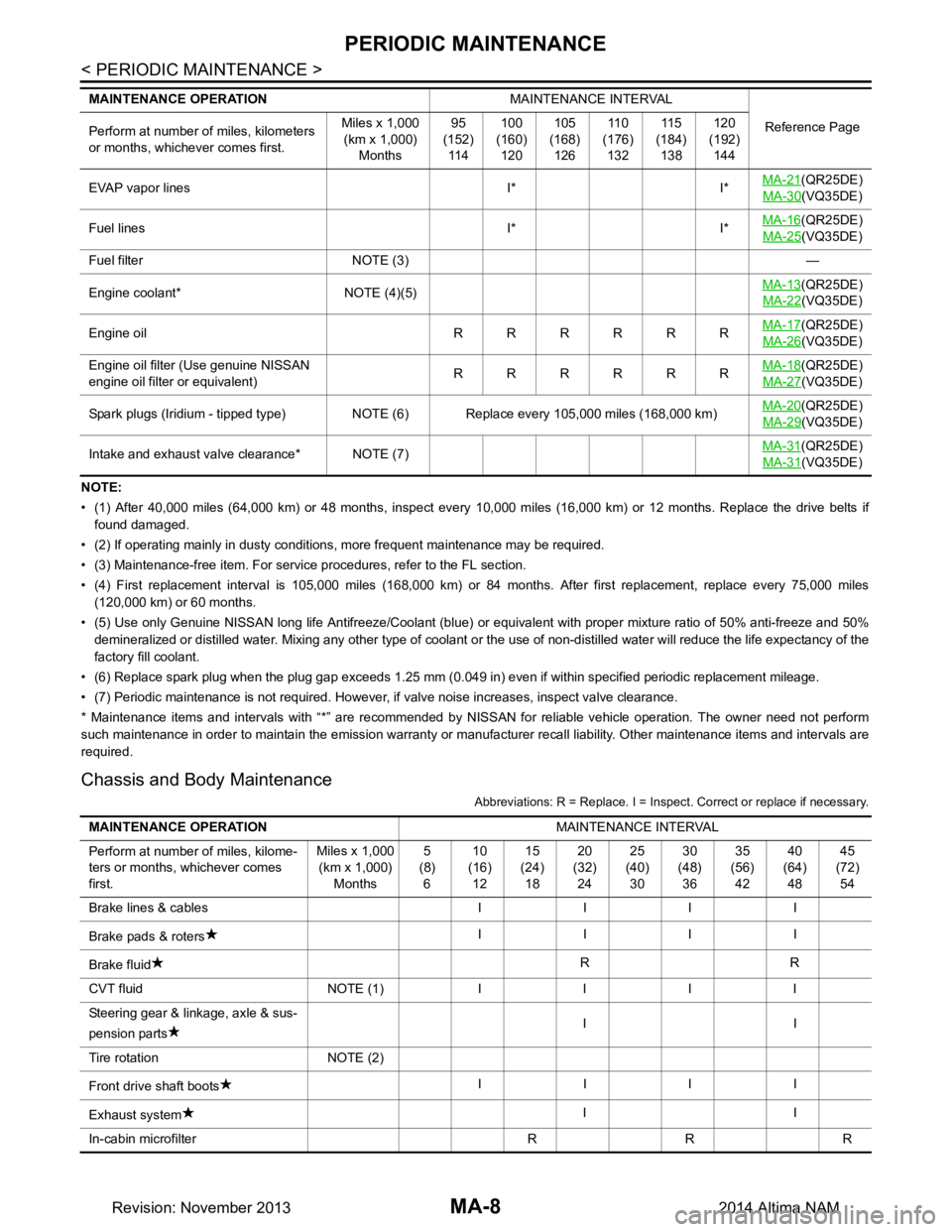2014 NISSAN TEANA mileage
[x] Cancel search: mileagePage 100 of 4801

BR-4
< PRECAUTION >
PRECAUTIONS
• Tighten the brake tube flare nut to the specified torque with
crowfoot (A) and torque wrench (B).
• Always confirm the specified ti ghtening torque when install-
ing the brake pipes.
• Turn the ignition switch OFF and disconnect the ABS actuator
and electric unit (control unit) connector or the battery nega-
tive terminal before performing the work.
• Check that no brake fluid leakage is present after replacing the parts.
• Burnish the brake contact surf aces after refinishing or replac-
ing rotors, after replacing pads, or if a soft pedal occurs at
very low mileage.
- Front brake: refer to BR-16, "Brake Burnishing"
.
- Rear brake: refer to BR-17, "Brake Burnishing"
.
JPFIA0001ZZ
Revision: November 20132014 Altima NAM
Page 112 of 4801

BR-16
< PERIODIC MAINTENANCE >
FRONT DISC BRAKE
FRONT DISC BRAKE
Brake BurnishingINFOID:0000000009463694
CAUTION:
• Burnish contact surfaces between brake pads and disc brake rotor according to the following proce-
dure after refinishing the disc brake rotor, replacing brake pads or if a soft pedal occurs at very low
mileage.
• Be careful of vehicle speed. Brakes do not operat e firmly/securely until pads and disc rotor are
securely seated.
• Only perform this procedure under safe road and traffic conditions. Use extreme caution.
1. Drive the vehicle on straight, flat road.
2. Depress the brake pedal until the vehicle stops.
3. Release the brake pedal for a few minutes to allow the brake components to cool.
4. Repeat steps 1 to 3 until pad and disc rotor are securely seated.
Revision: November 20132014 Altima NAM
Page 113 of 4801

REAR DISC BRAKEBR-17
< PERIODIC MAINTENANCE >
C
D E
G H
I
J
K L
M A
B
BR
N
O P
REAR DISC BRAKE
Brake BurnishingINFOID:0000000009463695
CAUTION:
• Burnish contact surfaces between brake pads and disc brake rotor according to the following proce-
dure after refinishing the disc brake rotor, replacing brake pads or if a soft pedal occurs at very low
mileage.
• Be careful of vehicle speed. Br akes do not operate firmly/securely until pads and disc rotor are
securely seated.
• Only perform this procedure under safe road and traffic conditions. Use extreme caution.
1. Drive the vehicle on straight, flat road.
2. Depress the brake pedal until the vehicle stops.
3. Release the brake pedal for a few minutes to allow the brake components to cool.
4. Repeat steps 1 to 3 until pad and disc rotor are securely seated.
Revision: November 20132014 Altima NAM
Page 130 of 4801

BR-34
< REMOVAL AND INSTALLATION >
FRONT DISC BRAKE
FRONT DISC BRAKE
BRAKE PAD
BRAKE PAD : Exploded ViewINFOID:0000000009463712
BRAKE PAD : Removal and InstallationINFOID:0000000009463713
WARNING:
Clean dust on brake calipers and brake pads with a vacuum dust collector to minimize the hazard of
airborne particles or other materials.
CAUTION:
• While removing brake caliper, do not depr ess brake pedal because piston will pop out.
• It is not necessary to remove bolts from torque member and brake hose except for disassembly or
replacement of brake caliper assembly. In this case, hang brake caliper with a wire so as not to
stretch brake hose.
• Do not damage piston boot.
• Keep brake rotor and brake pads free from brake fluid and grease.
• Burnish the brake pads and disc brake rotor mutual ly contacting surfaces after refinishing or replac-
ing disc brake rotors, after replacing brake pads, or if a soft pedal occurs at very low mileage. Refer
to BR-16, "Brake Burnishing"
.
REMOVAL
1. Partially drain brake fluid from the master cylinder. Refer to BR-14, "Drain and Refill".
2. Remove the front wheel and tire using power tool. Refer to WT-55, "Adjustment"
.
1. Inner shim cover 2. Inner shim 3. Inner pad
4. Outer pad 5. Pad retainer upper 6. Outer shim
7. Outer shim cover 8. Pad retainer lower A. Molykote AS-880N grease
B. Molykote 7439 grease
NOTE:
LH shown, RH similar
AWFIA1012ZZ
Revision: November 20132014 Altima NAM
Page 134 of 4801

BR-38
< REMOVAL AND INSTALLATION >
REAR DISC BRAKE
REAR DISC BRAKE
BRAKE PAD
BRAKE PAD : Exploded ViewINFOID:0000000009463716
BRAKE PAD : Removal and InstallationINFOID:0000000009463717
WARNING:
Clean dust on brake calipers and brake pads with a vacuum dust collector to minimize the hazard of
airborne particles or other materials.
CAUTION:
• While removing brake caliper, do not de press brake pedal because piston will pop out.
• Do not damage piston boot.
• Keep disc brake rotors and brake pa ds free from brake fluid and grease.
• Burnish the brake pads and disc brake rotors mutually contacting surfaces after refinishing or
replacing disc brake rotors, after replacing brake pads, or if a soft pedal occurs at very low mileage.
Refer to BR-17, "Brake Burnishing"
.
REMOVAL
1. Partially drain brake fluid from the master cylinder. Refer to BR-14, "Drain and Refill".
2. Remove rear wheel and tire using power tool. Refer to WT-55, "Adjustment"
.
3. Remove the upper and lower sliding pin bolts. Refer to BR-39,
"BRAKE CALIPER ASSEMBLY : Exploded View".
NOTE:
Note the sliding pin orientation during removal. The upper sliding
pin contains a bushing.
4. Remove brake caliper from torque member. Leavi ng brake hose attached, reposition the brake caliper
aside with wire.
1. Inner cover shim 2. Inner shim 3. Inner pad
4. Outer pad 5. Outer shim 6. Outer shim cover
7. Pad retainer A. Molykote AS-880N grease B. Molykote 7439 grease
AWFIA0940ZZ
ALFIA0288ZZ
Revision: November 20132014 Altima NAM
Page 3192 of 4801

MA-8
< PERIODIC MAINTENANCE >
PERIODIC MAINTENANCE
NOTE:
• (1) After 40,000 miles (64,000 km) or 48 months, inspect every 10,000 miles (16,000 km) or 12 months. Replace the drive belts if
found damaged.
• (2) If operating mainly in dusty conditions, more frequent maintenance may be required.
• (3) Maintenance-free item. For service procedures, refer to the FL section.
• (4) First replacement interval is 105,000 miles (168,000 km) or 84 months. After first replacement, replace every 75,000 miles (120,000 km) or 60 months.
• (5) Use only Genuine NISSAN long life Antifreeze/Coolant (blue) or equivalent with proper mixture ratio of 50% anti-freeze and 50%
demineralized or distilled water. Mixing any other type of coolant or the use of non-distilled water will reduce the life expec tancy of the
factory fill coolant.
• (6) Replace spark plug when the plug gap exceeds 1.25 mm (0.049 in) even if within specified periodic replacement mileage.
• (7) Periodic maintenance is not required. However, if valve noise increases, inspect valve clearance.
* Maintenance items and intervals with “*” are recommended by NISSAN for reliable vehicle operation. The owner need not perform
such maintenance in order to maintain the emission warranty or manufacturer recall liability. Other maintenance items and inter vals are
required.
Chassis and Body Maintenance
Abbreviations: R = Replace. I = Inspec t. Correct or replace if necessary.
EVAP vapor lines I* I* MA-21(QR25DE)
MA-30
(VQ35DE)
Fuel lines I* I* MA-16
(QR25DE)
MA-25
(VQ35DE)
Fuel filter NOTE (3) —
Engine coolant* NOTE (4)(5) MA-13
(QR25DE)
MA-22
(VQ35DE)
Engine oil RRRRRR MA-17
(QR25DE)
MA-26
(VQ35DE)
Engine oil filter (Use genuine NISSAN
engine oil filter or equivalent) RRRRRRMA-18
(QR25DE)
MA-27
(VQ35DE)
Spark plugs (Iridium - tipped type) NOTE (6) Replace every 105,000 miles (168,000 km) MA-20
(QR25DE)
MA-29
(VQ35DE)
Intake and exhaust valve clearance* NOTE (7) MA-31
(QR25DE)
MA-31
(VQ35DE)
MAINTENANCE OPERATION
MAINTENANCE INTERVAL
Reference Page
Perform at number of miles, kilometers
or months, whichever comes first. Miles x 1,000
(km x 1,000)
Months 95
(152)
11 4 100
(160)
120 105
(168)
126 11 0
(176)
132 11 5
(184)
138 120
(192)
144
MAINTENANCE OPERATION MAINTENANCE INTERVAL
Perform at number of miles, kilome-
ters or months, whichever comes
first. Miles x 1,000
(km x 1,000) Months 5
(8) 6 10
(16) 12 15
(24) 18 20
(32) 24 25
(40) 30 30
(48) 36 35
(56) 42 40
(64) 48 45
(72) 54
Brake lines & cables I I I I
Brake pads & roters IIII
Brake fluid RR
CVT fluid NOTE (1)IIII
Steering gear & linkage, axle & sus-
pension parts II
Tire rotation NOTE (2)
Front drive shaft boots IIII
Exhaust system II
In-cabin microfilter R R R
Revision: November 20132014 Altima NAM
Page 4171 of 4801

STC-20
< BASIC INSPECTION >
DIAGNOSIS AND REPAIR WORK FLOW
YES >> GO TO 6.
NO >> Check harness and connectors based on the information obtained by interview.
6.REPAIR OR REPLACE THE MALFUNCTIONING COMPONENTS.
• Repair or replace the malfunctioning components.
• Reconnect part or connector after repairing or replacing.
• When DTC is detected, erase self-diagnostic results for “EPS”.
>> GO TO 8.
7.IDENTIFY THE MALFUNCTIONING SYSTEM BY SYMPTOM DIAGNOSIS
Estimate the malfunctioning system based on symptom diagnosis and perform inspection.
Can the malfunctioning system be identified?
YES >> GO TO 8.
NO >> Check harness and connectors based on the information obtained by interview.
8.FINAL CHECK
With CONSULT
1. Check the reference value for power steering control module.
2. Recheck the symptom and check that sympto m is not reproduced on the same conditions.
Is the symptom reproduced?
YES >> GO TO 3.
NO >> Inspection End.
Diagnostic Work SheetINFOID:0000000009460355
Description
• In general, customers have their own criteria for a pr oblem. Therefore, it is important to understand the
symptom and status well enough by asking the customer about his/her concerns carefully. To systemize all
the information for the diagnosis, prepare the interview sheet referring to the interview points.
• In some cases, multiple conditions that appear simultaneously may cause a DTC to be detected.
Interview sheet sample
Interview sheet
Customer
name MR/MSRegistration
number Initial year
registration
Vehicle type VIN
Storage date Engine Mileage km (Mile)
Symptom �†
The steering wheel position (center) is in the wrong position.
�† Warning lamp turns on.
�† Noise �†Vibration
�† Others
( )
First occurrence �†Recently �†Others ( )
Frequency of occurrence �†Always �†Under a certain conditions of �†Sometimes (time(s)/day)
Climate con-
ditions �†
Irrelevant
Weather �†Fine �†Cloud �†Rain �†Snow �†Others ( )
Temperature �†Hot �†Warm �†Cool �†Cold �†Temperature [Approx. °C ( °F)]
Relative humidity �†High �†Moderate �†Low
Road conditions �†
Urban area �†Suburb area �†High way
�† Mountain road (uphill or down hill) �†Rough road
Revision: November 20132014 Altima NAMRevision: November 20132014 Altima NAM
Page 4172 of 4801

DIAGNOSIS AND REPAIR WORK FLOWSTC-21
< BASIC INSPECTION >
C
D E
F
H I
J
K L
M A
B
STC
N
O P
Operation conditions, etc. �†
Irrelevant
�† When engine starts �†During idling
�† During driving �†During acceleration �†At constant speed driving
�† During deceleration �†During cornering (right curve or left curve)
�† During steering
Other conditions
Memo Interview sheet
Customer
name MR/MSRegistration
number Initial year
registration
Vehicle type VIN
Storage date Engine Mileage km (Mile)
Revision: November 20132014 Altima NAMRevision: November 20132014 Altima NAM